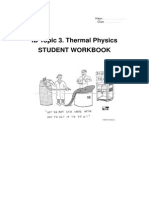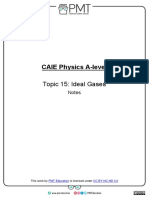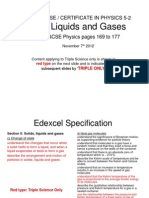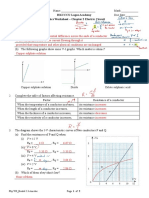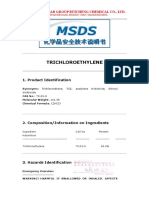0 ratings0% found this document useful (0 votes)
35 viewsPractice 5.2 (p.182) : 1 Heat and Gases Chapter 5 Gases
1. The document discusses gases and heat. It provides definitions and formulas related to gas properties like root-mean-square speed, kinetic energy, and pressure.
2. Key terms defined include root-mean-square speed, which is the average speed of gas molecules. The root-mean-square speed is directly proportional to the temperature.
3. Formulas provided relate gas properties like pressure, volume, temperature, number of moles, and kinetic energy. Total kinetic energy of a gas is directly proportional to temperature according to the formula for total kinetic energy.
Uploaded by
HiHiCopyright
© © All Rights Reserved
Available Formats
Download as DOC, PDF, TXT or read online on Scribd
0 ratings0% found this document useful (0 votes)
35 viewsPractice 5.2 (p.182) : 1 Heat and Gases Chapter 5 Gases
1. The document discusses gases and heat. It provides definitions and formulas related to gas properties like root-mean-square speed, kinetic energy, and pressure.
2. Key terms defined include root-mean-square speed, which is the average speed of gas molecules. The root-mean-square speed is directly proportional to the temperature.
3. Formulas provided relate gas properties like pressure, volume, temperature, number of moles, and kinetic energy. Total kinetic energy of a gas is directly proportional to temperature according to the formula for total kinetic energy.
Uploaded by
HiHiCopyright
© © All Rights Reserved
Available Formats
Download as DOC, PDF, TXT or read online on Scribd
You are on page 1/ 1
1 Heat and Gases Chapter 5 Gases
Practice 5.2 (p.182) = 470 m s1
1 C 10 Since total KE = nRT,
2 C
3 D increase in total KE
4 B = =
5 Root-mean-square speed
8290 J
=
11 (a) Triples
(b) Increases to 9 times the original value
= (c) Remains unchanged
12 (a) m is the mass of a gas molecule.
= 2150 m s–1
Nm is the mass of all gas molecules.
6 (a) The smoke particle move in random
motion. (b) Consider pV = and pV = nRT,
(b) It is bombarded by a large amount of air
we have = nRT
molecules around it. The bombardments
come from all sides but not in equal = nRT
numbers. This results in a random
motion Since the total kinetic energy of all gas
(c) It move slower. molecules is ,
7 (a) Increases
total kinetic energy of one mole of
(b) When the temperature increases, the air
molecules move faster. As the volume is molecules = = RT
fixed, the molecules hit the walls more
often. Also, each collision will give a
greater change in momentum due to the
increased speed. Therefore, the air
pressure inside the can increases.
8 The number of air molecules inside the tyre
increases, so there are more frequent
bombardments on the tyre wall. As a result,
the pressure of the tyre increases.
9 Root-mean-square speed
New Senior Secondary Physics at Work (Second Edition) 1
Oxford University Press 2015
You might also like
- IB Topic 3 Thermal Physics Question Booklet67% (3)IB Topic 3 Thermal Physics Question Booklet19 pages
- CHE 205 - Kinetic Theory of Gases - 24012022No ratings yetCHE 205 - Kinetic Theory of Gases - 2401202211 pages
- UNIT 3 - GASES (Part 2) Gases and The Kinetik Molecular ThoeryNo ratings yetUNIT 3 - GASES (Part 2) Gases and The Kinetik Molecular Thoery21 pages
- Kinetic-Molecular Theory: Ideal Gas Equation PV NRT100% (1)Kinetic-Molecular Theory: Ideal Gas Equation PV NRT9 pages
- Answers To End of Chapter Questions CambNo ratings yetAnswers To End of Chapter Questions Camb2 pages
- Thermodynamics Part II (Student Version)No ratings yetThermodynamics Part II (Student Version)67 pages
- KINETIC THEORY OF GASES AND RADIATION (lec 02)No ratings yetKINETIC THEORY OF GASES AND RADIATION (lec 02)6 pages
- Notes - Topic 15 Ideal Gases - CAIE Physics A-LevelNo ratings yetNotes - Topic 15 Ideal Gases - CAIE Physics A-Level5 pages
- 14.3__ideal_gases-cie_ial_physics-qp_theoryNo ratings yet14.3__ideal_gases-cie_ial_physics-qp_theory13 pages
- Gas Laws: February 10 & 11, 2010 Ms. KomperdaNo ratings yetGas Laws: February 10 & 11, 2010 Ms. Komperda27 pages
- Hsslive Xii Ch12 Kamil Notes Kinetic TheoryNo ratings yetHsslive Xii Ch12 Kamil Notes Kinetic Theory7 pages
- 2 1 Kinetic Particle Model of Matter 9v7YHDd0o F8hJSwNo ratings yet2 1 Kinetic Particle Model of Matter 9v7YHDd0o F8hJSw10 pages
- Negative Mass and Negative Refractive Index in Atom Nuclei - Nuclear Wave Equation - Gravitational and Inertial Control: Part 3: Gravitational and Inertial Control, #3From EverandNegative Mass and Negative Refractive Index in Atom Nuclei - Nuclear Wave Equation - Gravitational and Inertial Control: Part 3: Gravitational and Inertial Control, #3No ratings yet
- HKCCCU Logos Academy Physics Worksheet - Chapter 2 Electric Circuit 2.1 Electric CurrentNo ratings yetHKCCCU Logos Academy Physics Worksheet - Chapter 2 Electric Circuit 2.1 Electric Current2 pages
- HKCCCU Logos Academy Physics Worksheet - Chapter 2 Electric Circuit 2.1 Electric CurrentNo ratings yetHKCCCU Logos Academy Physics Worksheet - Chapter 2 Electric Circuit 2.1 Electric Current24 pages
- Unit 1 Naming and Formula WritingStoichiometryNo ratings yetUnit 1 Naming and Formula WritingStoichiometry30 pages
- LAB ACTIVITY NO 2 Understanding Measurements SI Units and Density ES 1No ratings yetLAB ACTIVITY NO 2 Understanding Measurements SI Units and Density ES 12 pages
- FLUENT 6.1 Features: General Modeling CapabilitiesNo ratings yetFLUENT 6.1 Features: General Modeling Capabilities9 pages
- Revised Finite Element Analysis of Reinforced Concrete Beams With Different Rebar Placements and Tension Anchorage OrientationsNo ratings yetRevised Finite Element Analysis of Reinforced Concrete Beams With Different Rebar Placements and Tension Anchorage Orientations47 pages
- Industrial Chemistry: The Haber Process & The Ostwald ProcessNo ratings yetIndustrial Chemistry: The Haber Process & The Ostwald Process16 pages
- Heat and Mass Transfer in A Clay-Pot Refrigerator: Analysis RevisitedNo ratings yetHeat and Mass Transfer in A Clay-Pot Refrigerator: Analysis Revisited15 pages
- Class11 Biology Unit12 NCERT TextBook EnglishEditionNo ratings yetClass11 Biology Unit12 NCERT TextBook EnglishEdition12 pages
- EP 222: Classical Mechanics Tutorial Sheet 1: 2 2 I I 2 I I, J I J 2 IjNo ratings yetEP 222: Classical Mechanics Tutorial Sheet 1: 2 2 I I 2 I I, J I J 2 Ij2 pages
- Autumn Break Assignment Chemistry Class 11No ratings yetAutumn Break Assignment Chemistry Class 113 pages
- Meen 611 Meen 619 Meen 622 Meen 627 Meen 629 Meen 631 Meen 642 Meen 643 Meen 644 Meen 665 Meen 679No ratings yetMeen 611 Meen 619 Meen 622 Meen 627 Meen 629 Meen 631 Meen 642 Meen 643 Meen 644 Meen 665 Meen 6793 pages
